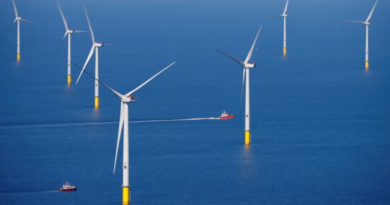Japan stakes its future on climate innovation, such as clean hydrogen, to help Asia become greener
Tokyo: From turning recycled clothing into biofuel for cars to using disposable diapers as a substitute for sand to make concrete to vending machines that suck carbon dioxide from the air, Japan’s private sector is not short of innovation to reduce its carbon footprint and that of the Asian region.
The government, for its part, is betting on clean hydrogen, although its nascent technology and low economies of scale mean the cost from production to distribution is said to be 10 times higher than that of natural gas.
Japan’s success on green initiatives, both by the government and private sector, will be pivotal for the region.
Through the Asia Zero Emission Community (Azec) framework, which includes Australia and all Asean countries except Myanmar, Prime Minister Fumio Kishida pledged in December 2023 to help Asia become greener by leading the development of new green technologies and necessary legal systems.
But the Japanese government has received flak from climate change experts and activists alike for not doing enough to spur innovation in the private sector, whether it is in developing hydrogen as a clean energy source or other green technologies.
Japan has been decades ahead of its time on hydrogen, having begun exploring the possible energy source 50 years ago as oil prices surged. But this failed to take off, given the high development costs and low demand from a world then ignorant of climate change.
Hydrogen, which boasts an energy yield 2.75 times higher than fossil fuels and does not emit carbon dioxide when used, is now the government’s top green priority. While its lead is shrinking, Japan still boasts the most patents for hydrogen technology in the world.
Japan has budgeted 3 trillion yen (S$27.1 billion) over the next 15 years to subsidise the production of “cleaner” forms of hydrogen, the Nikkei newspaper reported on January 30. To fund this and other green initiatives, Tokyo will issue, starting later in February, what is said to be the world’s first green transition sovereign bonds.
In December 2023, Singapore and Japan inked an agreement to promote digital and green practices in shipping, which will include pilot projects to test the use of zero- or near-zero-emission fuels such as ammonia and hydrogen.
Hydrogen is found in water and fossil fuels and is divided into three categories depending on how it is extracted.
The dirtiest, labelled “grey,” is largely being used today, with the hydrogen produced from fossil fuels such as natural gas and coal generating greenhouse gases that contribute to global warming and pollution.
The middle-of-the-road “blue” hydrogen uses the same processes as “grey” hydrogen but with the greenhouse gases being captured, stored, and potentially used.
The cleanest, “green” hydrogen is produced through the electrolysis of water using renewable energy.
However, Japan’s hydrogen plan has its critics, and there are still teething problems with the use of the energy by consumers. Experts are calling on the government to take a stronger lead.
Tokyo is seen as a laggard in its plans to spur innovation through subsidies to private companies, with many now dabbling in hydrogen technology on their own, including chemicals giant Asahi Kasei and materials manufacturer Toray Industries.
Automakers Toyota and Honda’s hydrogen fuel cell vehicles have faced lacklustre sales given the lack of refuelling facilities.
The government’s hydrogen scheme is also seen by climate change activists as a form of “greenwashing” while it continues to use fossil fuels in its energy mix.
Kimiko Hirata, the executive director of the non-profit Climate Integrate, found Japan’s track record to be mixed.
She told The Straits Times that she positively regarded an increase in investments and the ambition to expand offshore wind as an energy source but saw “no drastic shift” in its energy policy.
The basic position remains the same, she said, adding, “Japan’s green transformation does not necessarily promote the energy transition to renewables. By using fossil-based ammonia and hydrogen for thermal power, it allows existing industries to prolong their business even if the emitted carbon is captured and stored.”
Tokyo, however, counters that there is no one-size-fits-all formula for decarbonisation given the needs of fast-developing Asia. Through Azec, it advocates a gradual transition to help countries wean off polluting sources rather than immediately shunning fossil fuels.
While activists chaff at what they see as Japan’s slowness to change, its pledge in 2020 to achieve net-zero carbon emissions by 2050 was instrumental in catalysing more green innovation in the private sector, noted leading Japanese climatologist Mikiko Kainuma.
The innovations are diverse.
Beverage giant Asahi Holdings is rolling out nationwide vending machines that can suck carbon dioxide from the atmosphere via an absorbent material placed in the machine.
Thirty units of the so-called “CO2-eating vending machines” were installed by December 2023, with 500 units planned within 2024.
“We want to achieve vending machines that are carbon-neutral,” Takeshi Suganuma, the chief of Asahi’s future creation department focusing on innovation, told ST. Vending machines consume a lot of electricity to heat or cool beverages around the clock.
As carbon dioxide is used to produce fertiliser, concrete, and asphalt, Suganuma said there has already been interest shown in the agriculture and construction industries to buy the absorbed gas for their use.
Also looking at discreet environmental innovation is Panasonic, which is experimenting with embedding solar cells within the windows of homes and offices by printing perovskite, a transparent or tinted alternative material that can absorb light, directly onto glass.
The company already runs so-called “sustainable smart towns” in Fujisawa, south of Tokyo, and Suita in Osaka that are largely powered by the energy produced by on-site solar panels.
Startups are also looking at green innovation, such as Jeplan, which was among Japan’s pioneering green startups when the clothes and plastics recycling firm was launched in 2007.
Masaki Takao, now 43, founded the company, appalled by the millions of tonnes of waste that is generated by the apparel industry globally every year.
Jeplan runs two factories in Japan: one in Kitakyushu recycles clothes, while another in Kawasaki recycles plastic. Today, it counts American outdoor wear maker Patagonia among its clients and is also working with the United Arab Emirates on plastic recycling.
Its clothes recycling technology converts discarded clothing into bioethanol, which can be used as fuel for cars or made into polyester pellets that can be remade into clothes.
In 2022, Jeplan collected 1,101 metric tons of clothes that can be turned into about 4.4 million pieces of new clothing, up from 1,014 metric tons in 2021, a figure that he said is still far from ideal.
Takao told ST that he saw a challenge in converting awareness into practicable action.
He said, “In theory, awareness of climate issues should result in people actively choosing recyclable products. But in practice, they find it troublesome or expensive to change their lifestyles completely.”
Elsewhere, other startups are devising new ways to make faux leather from waste materials such as peanut skins, apple peels, and mushrooms. In Kitakyushu, researchers have discovered that disposable diapers can be used to replace between nine and 40 percent of the sand required to make concrete without reducing its strength.
“As consumers and investors become more conscious of environmental issues, more companies will begin manufacturing eco-friendly products,” Takeshi Okuwaki of the Dai-Ichi Life Research Institute told Yomiuri Shimbun. “I think it will spread to daily necessities as well.”
To speed up innovation and adoption, Dr. Kainuma said the government needs to show more support for the disparate green efforts by individual private companies.
Noting that innovation remains cost-prohibitive, she felt it was urgent for the government to consider ways to cut costs, catalyse more innovation, including by expanding industrial clusters, and encourage consumers to adopt greener practices.
“Private companies have, to some extent, heeded the clarion call to adopt sustainable development goals,” she said. “But it seems they are not yet reaping results, and the government needs to do more.”
She also disagreed with government plans for imported renewable energy to remain part of the energy mix by 2050. Using hydrogen as well as other sources such as solar and wind, she said, “We should instead be aiming for 100 percent renewable energy in our own country.” The Straits Times/ANN
Source : thestar.com.my




